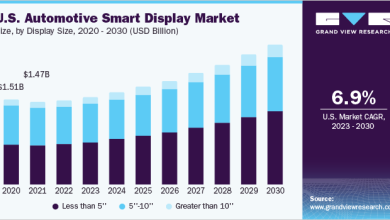Automotive digital cockpit market forecasts for 2030

Infinity business insights have recently launched the latest report on Automotive Digital Cockpit Market 2023-2030 for its clients. This report offers the clients factual data validated by industry experts and business heads. The report provides a chapter-wise explanation for every aspect of the Automotive Digital Cockpit market. It discusses the drivers, trends, opportunities, leading, and trending segments in detail, accompanied by specific examples. Profiles of leading players are also discussed along with their business expansion strategies.
The global automotive digital cockpit market will experience a 15% CAGR from 2023 to 2030 and will reach a value of USD 5 billion by 2030. Therefore, the automotive digital cockpit market focuses on transforming the traditional dashboard into a digital, interactive interface that provides essential vehicle information and infotainment features. Digital cockpits integrate various displays, touchscreens, voice recognition, and gesture controls to enhance the driving experience and passenger engagement. Moreover, they offer features like navigation, entertainment, vehicle diagnostics, and connectivity to smartphones and other devices. As vehicles become more connected and autonomous, furthermore, the demand for advanced digital cockpit solutions is expected to grow.
Top Companies in the Global Automotive Digital Cockpit Market:
HARMAN, Panasonic, Bosch, Denso Corporation, Alpine, Continental, Visteon, Pioneer, Marelli, Joyson, Desay SV, Clarion, JVCKenwood, Yanfeng, Nippon Seiki, Hangsheng Electronics, Valeo, Neusoft, Foryou Corporation, Luxoft Holding, among others.
After studying key companies, the report shifts its focus to the startups contributing to the market’s growth. Subsequently, the report’s authors identify possible mergers and acquisitions among the startups and key organizations in the study. Moreover, most companies in the Online Business Courses market are currently adopting new technologies, strategies, product developments, expansions, and long-term contracts to maintain their dominance in the global Online Business Courses market. With the advent of new technologies regularly, players are striving hard to incorporate the latest technology to gain a competitive edge above the rest.
Based on Types, the Global Automotive Digital Cockpit Market is Segmented into:
- In-vehicle Infotainment
- Digital Instrument Cluster
- HUD
- Digital Rearview Mirror
- Rear-seat Infotainment Solutions
- Others
Based on Application, the Global Automotive Digital Cockpit Market is Segmented into:
- Economic Vehicle
- Mid-Price Vehicle
- Luxury Vehicle
Regions covered by the Automotive Digital Cockpit Market Report 2023 to 2030
The automotive digital cockpit market displays distinct regional trends shaping its landscape. Furthermore, North America leads with a mature automotive industry and technological innovation. This, in turn, drives demand for advanced digital cockpits that enhance user experience and connectivity. In Europe, a focus on luxury and premium vehicles and stringent safety regulations enhances the market, particularly in countries with well-established automotive manufacturing. Asia-Pacific experiences rapid growth due to expanding vehicle markets and increasing consumer demand for tech-savvy features, necessitating user-friendly and cost-effective digital cockpit solutions. Latin America and the Middle East are emerging markets, witnessing heightened adoption of digital cockpits to cater to evolving consumer preferences. Africa, while nascent, shows potential as automotive markets develop.
These regional dynamics impact market competition, pricing strategies, and cockpit offerings by manufacturers. Recognizing these variations empowers stakeholders to tailor strategies to meet regional automotive standards, regulatory requirements, and consumer expectations, contributing to the overall advancement of the automotive digital cockpit market.
- North America (United States, Canada, and Mexico)
- Europe (Germany, France, UK, Russia, and Italy)
- Asia-Pacific (China, Japan, Korea, India, and Southeast Asia)
- South America (Brazil, Argentina, Colombia, etc.)
- Middle East and Africa (Saudi Arabia, UAE, Egypt, Nigeria, and South Africa)
Geographical markets are of great importance for investors since a detailed report offers core areas to identify potential prospects. Strategic initiatives under regional analysis display mergers, acquisitions, collaborations, and joint ventures between key players. Innovation is been the driving force for these players and in the mode of business expansion, players are now leaping and investing in other ventures for mutual profits. Thus, it ensure chapter-wise segmentation and data analysis for every region.



